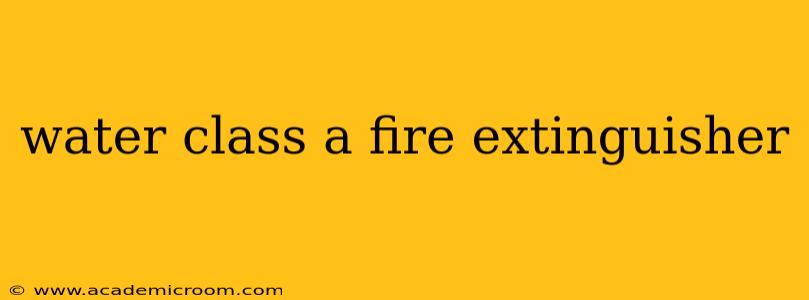Water is a fundamental element in fire suppression, particularly for Class A fires involving ordinary combustible materials like wood, paper, cloth, and plastics. Understanding the capabilities and limitations of water class A fire extinguishers is crucial for effective fire safety. This guide will delve into the specifics, addressing common questions and concerns.
What is a Class A Fire Extinguisher?
A Class A fire extinguisher is specifically designed to combat Class A fires. These fires are fueled by ordinary combustible materials and are extinguished by cooling the burning material below its ignition temperature. Water is the primary extinguishing agent in most Class A extinguishers due to its excellent cooling capacity and relative affordability. However, it's crucial to remember that water is not suitable for all fire types.
What are the Different Types of Water Class A Fire Extinguishers?
While the core extinguishing agent is water, there are variations in the design and functionality of Class A fire extinguishers:
-
Stored Pressure Water Extinguishers: These are the most common type. The water is pressurized within the extinguisher itself, ready for immediate use. They are relatively inexpensive and easy to maintain.
-
Water Cartridge Operated Extinguishers: These extinguishers separate the water supply from the pressurizing gas. The gas is released only when the extinguisher is activated, extending the shelf life of the water.
-
Water Mist Extinguishers: These extinguishers use a fine spray of water, enhancing its cooling and penetrating capabilities. They are particularly effective on smaller fires and are less likely to cause water damage.
What Types of Fires Can a Water Class A Fire Extinguisher Put Out?
Water Class A fire extinguishers are highly effective against Class A fires involving:
- Wood: Furniture, pallets, lumber
- Paper: Documents, cardboard boxes
- Cloth: Upholstery, clothing
- Plastics: Some plastics (check the specific extinguisher rating)
Crucially, water should never be used on Class B (flammable liquids), Class C (energized electrical equipment), or Class D (combustible metals) fires. Attempting to use water on these types of fires can be extremely dangerous and may even worsen the situation.
How to Use a Water Class A Fire Extinguisher?
Remember the acronym PASS:
- Pull the pin.
- Aim at the base of the fire.
- Squeeze the lever.
- Sweep from side to side.
Always maintain a safe distance from the fire and be prepared to retreat if the fire becomes uncontrollable. If the fire is too large or spreading rapidly, evacuate the area immediately and call emergency services.
What are the Limitations of Water Class A Fire Extinguishers?
While effective for Class A fires, water-based extinguishers have limitations:
- Electrical Fires: Water conducts electricity and can cause electrocution if used on energized electrical equipment.
- Flammable Liquid Fires: Water will spread flammable liquids, making the fire larger and more difficult to control.
- Grease Fires: Water can cause a violent reaction with hot grease, resulting in a flash fire.
- Water Damage: Using water extinguishers can cause significant water damage to property.
How Often Should I Get My Water Class A Fire Extinguisher Serviced?
Regular servicing is critical for maintaining the functionality and safety of your fire extinguisher. The frequency of service varies depending on local regulations and the type of extinguisher, but annual inspections are generally recommended. A qualified technician should perform these inspections and recharging as needed.
How Do I Choose the Right Water Class A Fire Extinguisher?
The size and type of extinguisher you need will depend on the potential fire hazards in your area. Consider factors such as the size of the space, the types of materials present, and the potential for fire spread when selecting the appropriate extinguisher. Consulting a fire safety professional is recommended to ensure you have the right equipment for your specific needs.
This comprehensive guide should equip you with a thorough understanding of water class A fire extinguishers. Remember, fire safety is paramount. Knowing how to use and maintain your extinguisher can make the difference between a minor incident and a major disaster.
